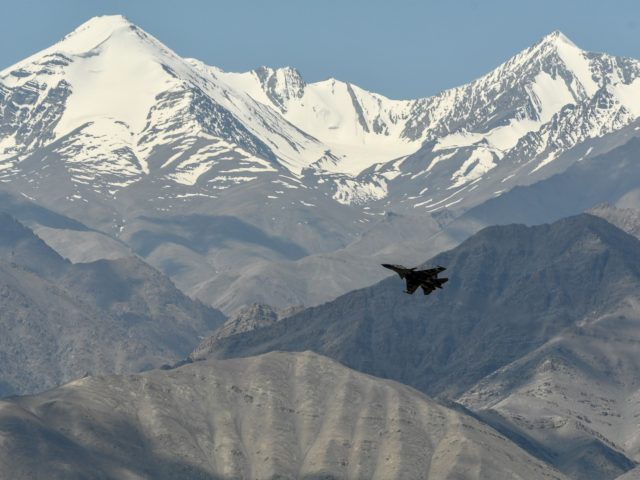The Chinese People’s Liberation Army (PLA) carried out live-fire drills in the Himalayas at the end of July, publicly debuting some of the army’s latest weapons, including “a new 122-millimeter caliber wheeled howitzer and a vehicle-mounted version of the HJ-10 anti-tank missile system,” the PLA’s official English-language website reported Thursday.
“A combined arms brigade attached to the PLA Tibet Military Command recently conducted a series of live-fire artillery exercises in the middle section of the Himalayas, which has an elevation of about 4,600 meters [15,000 feet],” state-run China Central Television (CCTV) reported on Tuesday.
The drills reportedly simulated anti-aircraft shooting and precision artillery strikes on hostile targets – such as missile installations and communication hubs – using long-range rocket launcher systems.
“This was followed by live-fire coverage of hostile positions, bunkers, and camps with howitzers,” according to the report.
Although the report failed to note the designation of the new howitzer debuted in the drills, Chinese military observers told the Chinese Communist Party (CCP) mouthpiece Global Times that it “looks very similar to and uses similar technologies as the PCL-181 155-millimeter caliber wheeled howitzer, which made its public debut at China’s National Day military parade in 2019.”
The 2019 version “has a shorter barrel and four wheels instead of the [new] PCL-181’s six wheels,” Shanghai-based news website eastday.com noted on Tuesday. According to the report, this means that “the new 122-millimeter caliber wheeled howitzer can shoot in all directions and can be deployed rapidly, a significant advantage over its … predecessor.”
“[C]ompared with the 155-millimeter caliber PCL-181, the new 122-millimeter caliber howitzer is more mobile and better-suited for air transport via tactical cargo planes like the Y-9,” the Global Times wrote on Tuesday, quoting Beijing-based “military expert” Wei Dongxu.
“At the cost of range and firepower, the new howitzer’s smaller and lighter ammunition is easier to transport and reload,” Wei added.
“In plateau warfare, wheeled vehicles can often enjoy an advantage over vehicles that use tracks, which are heavy and are affected by lower levels of oxygen,” the Global Times wrote, quoting Chinese military analysts. “Compared with their heavier counterparts, these two new weapons [the howitzer and anti-tank missile system] are characterized by high mobility, which will come in handy – particularly in plateau regions.”
News of the PLA’s live-fire drills comes as China remains engaged in an unresolved border dispute with India along their shared border in the Himalayas. On June 16, Indian and Chinese border troops clashed in the Himalayas’ disputed Galwan Valley, resulting in the deadliest border conflict between the two countries since 1975. The skirmish killed 20 Indian soldiers and an estimated 40 Chinese troops, though Beijing never officially confirmed its number of casualties. Although both sides claim to have largely “disengaged” from the standoff, the PLA’s recent live-fire drills – and a report late last month that India plan’s to deploy an additional 35,000 troops to the border – suggest otherwise.
India is not the only country Beijing tries to intimidate through increasing hostile military drills. The PLA has carried out military exercises in and around Taiwanese territory for years and has recently ramped up its aggressive activity toward the small, independent island in East Asia. Though self-ruled, Bejing considers Taiwan a breakaway province and has vowed to reunify it with China by force if necessary.
On Thursday, Taiwan said it would increase its defense budget by $1.4 billion next year in the face of the PLA’s incessant military drills, which threaten the island’s sovereign territory.

COMMENTS
Please let us know if you're having issues with commenting.